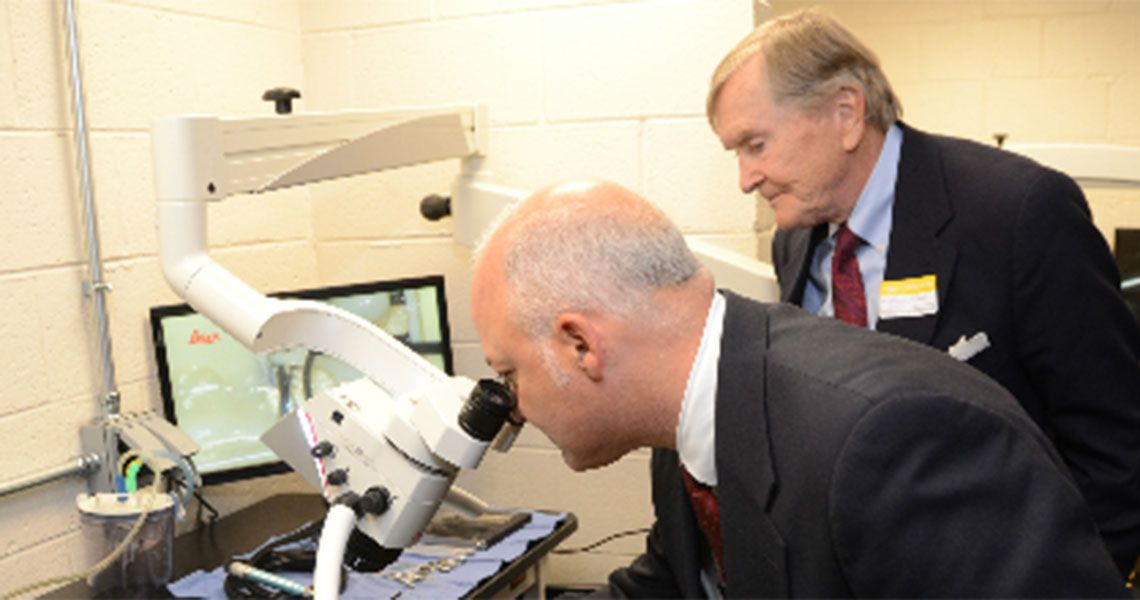Excelling in fine motor skills requires countless hours of practice. As a musician, dancer, or athlete trains daily to do his or her best, residency training is no different— practice makes perfect. Students, staff, and faculty gathered in Ross Hall for the grand opening of the Center for Otolaryngology Microsurgery Education and Training (COMET), March 20. The six station lab took nearly a year to complete and will be used as a surgical training and simulation center for otology and lateral skull-base surgery. The establishment of this center was made possible in part by contributions from grateful patients. Donors include David and Katherine Bradley, who made a gift in recognition of care provided by Steven Bielamowicz, M.D., professor and chief of the division of otolaryngology at the George Washington (GW) University School of Medicine and Health Sciences (SMHS), as well as the late Mary C. Griffiths, who was a patient of Julianna Gulya, M.D., a past associate professor at SMHS. Griffiths’ nephew, John Griffiths, along with his twin daughters, Loralei and Isabella made the trip from Ironton, Ohio to celebrate the opening of the new space. The team that oversaw the simulation center from start to finish included Bielamowicz, Ashkan Monfared, M.D., director of otology and neurotology and assistant professor of surgery and neurosurgery, and Anton N. Sidawy, M.D., Lewis B. Saltz Professor and Chair of the department of surgery at SMHS.
With this new technology, residents will be able to simulate several different surgical techniques involving the pathological anatomy and physiology of the human ear. “We have built devices to simulate structures as small as a human middle ear with the smallest bones and muscles in the body,” said Monfared. Middle ear is the portion of the ear internal to the eardrum and external to the oval window of the cochlea. “My hope is that one day residents will be able to perform dozens, if not hundreds, of these types of simulations before they enter the operating room.”
Residents will practice most aspects of an ear, nose, and throat (ENT) doctor’s responsibilities in the simulation center. These simulations include ear surgery and skull-base surgery, which is the area where doctors operate on tumors that grow between the brain and the ear or between the brain and the nose. Residents will also be able to drill and sculpt the temporal bones, which are situated at the sides and base of the skull and lateral to the temporal lobes of the cerebrum. In addition, the center is equipped with objects that simulate ENT body parts, like middle ear. “There are parts of surgery that you can’t practice before you walk into an operating room,” said Monfared “You learn the techniques in an animal or temporal bone lab. There are things you can’t do because you don’t have the identical pieces, but with this simulation center we will have those,” he said.
Being able to practice his surgery skills at any time is very exciting for Alex Cheng, M.D., a fourth-year otolaryngology resident at SMHS. “Residency is about practicing surgery with guidance from our attending physicians,” said Cheng. “This simulation center is just another way we can further improve our skills as surgeons, which will ultimately improve our patient care,” said Cheng.
The simulation center is currently housed in the animal facility in the basement of Ross Hall. The lab will eventually move upstairs to become a part of the George Washington Simulation Center.
For Johnny Mai, M.D., an otolaryngology intern at SMHS, the new simulation center is a great opportunity for hands-on training. “I think this lab will increase residents’ comfort level working with such a complex anatomy,” said Mai. “It’s very special to be able to work in this temporal bone lab because not every ENT program in the country is equipped with this type of training lab.”
“Having this simulation center will better equip the next generation of residents for ever advancing complex surgeries,” said Monfared, who hopes to further expand the COMET to include surgical simulation of other branches of otolaryngology besides otology and skull-base surgery.



